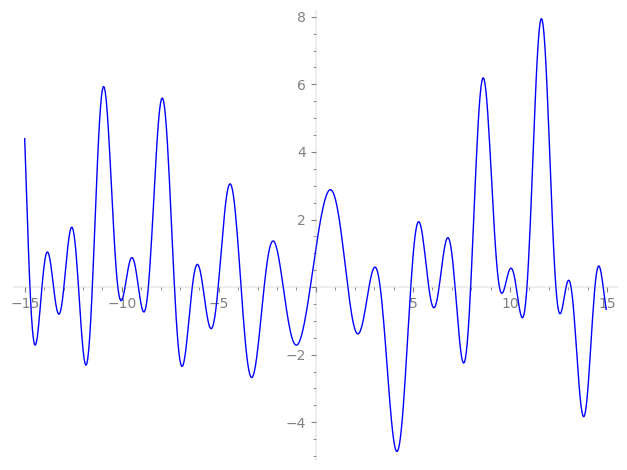| L(s) = 1 | + (7.75 − 4.47i)5-s − 8.60·7-s − 12.8i·11-s + (−11.6 + 20.2i)13-s + (22.1 − 12.7i)17-s + (−18.2 + 5.32i)19-s + (0.190 + 0.110i)23-s + (27.5 − 47.7i)25-s + (−33.8 − 19.5i)29-s + 10.5·31-s + (−66.7 + 38.5i)35-s − 20.5·37-s + (50.6 − 29.2i)41-s + (−24.2 − 41.9i)43-s + (−71.7 − 41.4i)47-s + ⋯ |
| L(s) = 1 | + (1.55 − 0.895i)5-s − 1.22·7-s − 1.16i·11-s + (−0.897 + 1.55i)13-s + (1.30 − 0.750i)17-s + (−0.959 + 0.280i)19-s + (0.00829 + 0.00479i)23-s + (1.10 − 1.91i)25-s + (−1.16 − 0.673i)29-s + 0.339·31-s + (−1.90 + 1.10i)35-s − 0.554·37-s + (1.23 − 0.713i)41-s + (−0.563 − 0.975i)43-s + (−1.52 − 0.881i)47-s + ⋯ |
\[\begin{aligned}\Lambda(s)=\mathstrut & 1368 ^{s/2} \, \Gamma_{\C}(s) \, L(s)\cr =\mathstrut & (-0.876 + 0.482i)\, \overline{\Lambda}(3-s) \end{aligned}\]
\[\begin{aligned}\Lambda(s)=\mathstrut & 1368 ^{s/2} \, \Gamma_{\C}(s+1) \, L(s)\cr =\mathstrut & (-0.876 + 0.482i)\, \overline{\Lambda}(1-s) \end{aligned}\]
Particular Values
| \(L(\frac{3}{2})\) |
\(\approx\) |
\(1.134134308\) |
| \(L(\frac12)\) |
\(\approx\) |
\(1.134134308\) |
| \(L(2)\) |
|
not available |
| \(L(1)\) |
|
not available |
\(L(s) = \displaystyle \prod_{p} F_p(p^{-s})^{-1} \)
| $p$ | $F_p(T)$ |
|---|
| bad | 2 | \( 1 \) |
| 3 | \( 1 \) |
| 19 | \( 1 + (18.2 - 5.32i)T \) |
| good | 5 | \( 1 + (-7.75 + 4.47i)T + (12.5 - 21.6i)T^{2} \) |
| 7 | \( 1 + 8.60T + 49T^{2} \) |
| 11 | \( 1 + 12.8iT - 121T^{2} \) |
| 13 | \( 1 + (11.6 - 20.2i)T + (-84.5 - 146. i)T^{2} \) |
| 17 | \( 1 + (-22.1 + 12.7i)T + (144.5 - 250. i)T^{2} \) |
| 23 | \( 1 + (-0.190 - 0.110i)T + (264.5 + 458. i)T^{2} \) |
| 29 | \( 1 + (33.8 + 19.5i)T + (420.5 + 728. i)T^{2} \) |
| 31 | \( 1 - 10.5T + 961T^{2} \) |
| 37 | \( 1 + 20.5T + 1.36e3T^{2} \) |
| 41 | \( 1 + (-50.6 + 29.2i)T + (840.5 - 1.45e3i)T^{2} \) |
| 43 | \( 1 + (24.2 + 41.9i)T + (-924.5 + 1.60e3i)T^{2} \) |
| 47 | \( 1 + (71.7 + 41.4i)T + (1.10e3 + 1.91e3i)T^{2} \) |
| 53 | \( 1 + (22.9 + 13.2i)T + (1.40e3 + 2.43e3i)T^{2} \) |
| 59 | \( 1 + (-46.2 + 26.6i)T + (1.74e3 - 3.01e3i)T^{2} \) |
| 61 | \( 1 + (36.4 - 63.1i)T + (-1.86e3 - 3.22e3i)T^{2} \) |
| 67 | \( 1 + (44.6 - 77.3i)T + (-2.24e3 - 3.88e3i)T^{2} \) |
| 71 | \( 1 + (60.2 - 34.7i)T + (2.52e3 - 4.36e3i)T^{2} \) |
| 73 | \( 1 + (12.1 + 21.0i)T + (-2.66e3 + 4.61e3i)T^{2} \) |
| 79 | \( 1 + (24.9 + 43.1i)T + (-3.12e3 + 5.40e3i)T^{2} \) |
| 83 | \( 1 + 21.4iT - 6.88e3T^{2} \) |
| 89 | \( 1 + (-45.6 - 26.3i)T + (3.96e3 + 6.85e3i)T^{2} \) |
| 97 | \( 1 + (46.2 + 80.1i)T + (-4.70e3 + 8.14e3i)T^{2} \) |
| show more | |
| show less | |
\(L(s) = \displaystyle\prod_p \ \prod_{j=1}^{2} (1 - \alpha_{j,p}\, p^{-s})^{-1}\)
Imaginary part of the first few zeros on the critical line
−9.141584573365198489636261237394, −8.631687006470716232518122730252, −7.28510223977246629547361822297, −6.36846321279315169495863763318, −5.81879444849274393855191528107, −5.03520714500933559942246968913, −3.85326423473340711756294067060, −2.66704011542795230211824024324, −1.68249153125609701252193366896, −0.28959253537834436100079276279,
1.64514328941700164446203080159, 2.73430704662190719457680512939, 3.31160929520451050998163095849, 4.88629351438128064292018209095, 5.81516808405757085596910924099, 6.34559883243024753011172204649, 7.16889208444069557998571601326, 7.971520233245814024232879713730, 9.452596153105540156937202365251, 9.727469641599448322600194896475

